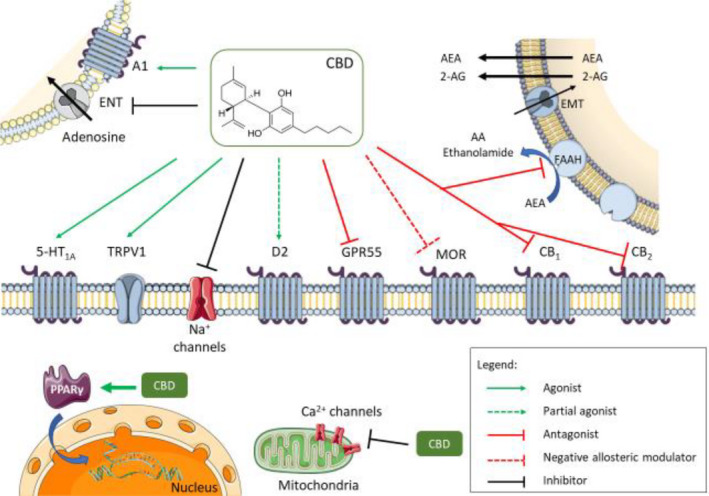FIGURE 1.

Multiple molecular targets for CBD – Cannabidiol has multiple molecular targets within the cell. It behaves as an antagonist for cannabinoid CB1 and CB2 receptors; however, some of the cannabinoid‐mediated effects attributed to CBD may be due to its ability to inhibit endocannabinoid degradation through the FAAH enzyme. This, in turn, increases endocannabinoid levels causing receptor activation, mainly by anandamide. The full agonism at 5‐HT1A serotonin receptors and TRPV1 channels is responsible for the anxiolytic and analgesic effects in animals. Partial agonism at D2 dopamine receptors might account for the effects of CBD on emotional memory processing by the ventral hippocampus. Full agonism at adenosine A1 receptors might have beneficial effects on cardiac arrythmias and ischemia/reperfusion lesions in the myocardium. The negative allosteric modulation of MOR is an important CBD feature in controlling opioid drug abuse and relapse. Agonism of intracellular PPARγ receptors causes changes in gene transcription and is responsible for the positive effect of CBD on glucose and fatty acid metabolism both in animals and in humans. CBD has an overall inhibitory effect on sodium and calcium channels exerting a modulatory effect on membrane electrical potential; this would suggest CBD as a potential therapeutic for the treatment of epilepsy. CBD, cannabidiol; A1, Adenosine receptor 1; ENT, equilibrative nucleotide transporter; AEA, anandamide; 2‐AG, 2‐arachidonoylethanolamide; EMT, endocannabinoid membrane transporter; 5‐HT1A, 5‐hidroxytriptamine 1A receptor; TRPV1, transient receptor potential vanilloid 1; D2, dopamine receptor 2; GPR55, G protein coupled receptor 55; MOR, µ opioid receptor; PPARγ, peroxisome proliferator‐activated receptor gamma; CB1, cannabinoid receptor 1; CB2, cannabinoid receptor 2
